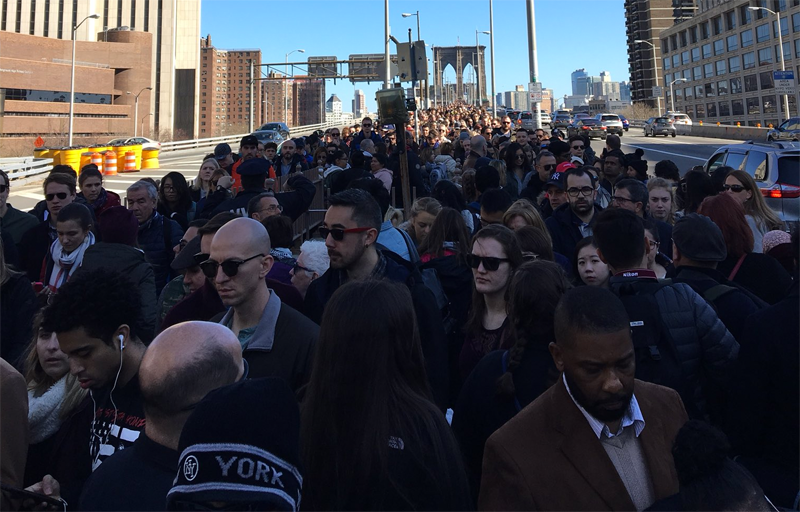Saturday marked the year's first gorgeous spring weekend. Naturally, everyone and their mother flocked to the Brooklyn Bridge, which quickly filled to capacity. At least, the promenade did -- the car lanes below still had plenty of room.
On the promenade, there was barely room to walk, and biking was out of the question. The crowds shuffled along in a claustrophobic procession, visible in a stream of photos shared on Twitter.
So many people were crammed together at one point that NYPD restricted entry, according to one report. It was an extreme version of what happens on the Brooklyn Bridge nearly every nice, sunny day.
.@nypd84: we’re all stuck here on the Brooklyn Bridge. Please don’t let anyone else on. pic.twitter.com/hFwCYFcyrF
— Brian Howald (@bdhowald) March 31, 2018
Pedestrian crowding on the bridge has intensified in recent years, making it an increasingly unworkable bike route, despite being a far more direct path between Brooklyn and Lower Manhattan or the West Side Greenway than the Manhattan Bridge. Unlike the three other East River bridges, where daily bike crossings have risen over the last decade, the number of people biking over the Brooklyn Bridge is declining.
DOT has a long-term plan to relieve crowding by widening the promenade, but it's alarmingly clear that the situation has to be addressed faster than the agency's timetable allows. In December, DOT announced plans to study the feasibility of expanding the promenade, with more separation between pedestrians and cyclists. But even if the study concludes that the promenade can be widened, construction would not wrap up until 2023 at the earliest.
The city could provide immediate relief by repurposing a traffic lane for bicycling on the bridge roadway. DOT has rejected that option, citing potential traffic impacts in downtown Brooklyn as the primary obstacle to a roadway bike path.
But the agency only modeled the feasibility of a path on the Manhattan-bound side of the bridge. A path on the Brooklyn-bound side of the bridge would presumably affect traffic less, since the evening rush hour is more dispersed. Whatever the impacts on car traffic may be, the plight of people walking and biking should take precedence.
The city has floated some short- to medium-term ideas that would relieve some of the worst bottlenecks, including a bike ramp on the Manhattan side that would bypass the path's narrow entrance. DOT also wants to limit vending on the promenade.
Those tweaks will provide modest relief, but on many days the bridge will remain cramped and miserable unless DOT takes a lane from car traffic.






